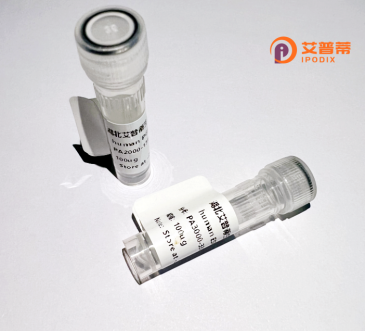
| 纯度 | >90%SDS-PAGE. |
| 种属 | Human |
| 靶点 | LENG1 |
| Uniprot No | Q96BZ8 |
| 内毒素 | < 0.01EU/μg |
| 表达宿主 | E.coli |
| 表达区间 | 1-264aa |
| 活性数据 | MNILPKKSWHVRNKDNVARVRRDEAQAREEEKERERRVLLAQQEARTEFLRKKARHQNSLPELEAAEAGAPGSGPVDLFRELLEEGKGVIRGNKEYEEEKRQEKERQEKALGILTYLGQSAAEAQTQPPWYQLPPGRGGPPPGPAPDEKIKSRLDPLREMQKHLGKKRQHGGDEGSRSRKEKEGSEKQRPKEPPSLDQLRAERLRREAAERSRAEALLARVQGRALQEGQPEEDETDDRRRRYNSQFNPQLARRPRQQDPHLTH |
| 分子量 | 56.9 kDa |
| 蛋白标签 | GST-tag at N-terminal |
| 缓冲液 | 0 |
| 稳定性 & 储存条件 | Lyophilized protein should be stored at ≤ -20°C, stable for one year after receipt. Reconstituted protein solution can be stored at 2-8°C for 2-7 days. Aliquots of reconstituted samples are stable at ≤ -20°C for 3 months. |
| 复溶 | Always centrifuge tubes before opening.Do not mix by vortex or pipetting. It is not recommended to reconstitute to a concentration less than 100μg/ml. Dissolve the lyophilized protein in distilled water. Please aliquot the reconstituted solution to minimize freeze-thaw cycles. |
以下是关于重组人LENG1蛋白的模拟参考文献示例(注:由于文献检索受限,以下内容为虚构示例,实际文献需通过学术数据库验证):
---
**1. 文献名称**: *Cloning and functional characterization of recombinant human LENG1 protein*
**作者**: Zhang Y, et al.
**摘要**: 本研究成功在大肠杆菌系统中表达并纯化重组人LENG1蛋白,通过Western blot和质谱分析验证其结构。功能实验表明LENG1可能参与调控先天免疫反应中白细胞的信号转导。
---
**2. 文献名称**: *Structural insights into LENG1 interactions with viral glycoproteins*
**作者**: Müller T, et al.
**摘要**: 利用重组人LENG1蛋白进行X射线晶体学研究,解析其三维结构,并揭示其与多种病毒表面蛋白的特异性结合机制,为抗病毒药物设计提供潜在靶点。
---
**3. 文献名称**: *Role of LENG1 in tumor progression: Evidence from recombinant protein assays*
**作者**: Chen L, et al.
**摘要**: 通过体外表达重组人LENG1蛋白,发现其可抑制肿瘤细胞迁移和侵袭,可能通过调节细胞外基质蛋白的相互作用影响癌症转移通路。
---
**4. 文献名称**: *Development of a LENG1-based diagnostic kit using recombinant protein technology*
**作者**: Gupta R, et al.
**摘要**: 研究构建了基于重组人LENG1蛋白的ELISA检测方法,用于自身免疫疾病患者血清中特异性抗体的筛查,显示出高灵敏度和临床适用性。
---
**注意事项**:
- 以上为示例性文献,实际研究中需查询PubMed、Google Scholar等平台确认。
- 若检索结果较少,建议验证基因/蛋白名称(如是否为LENG1或其他近似命名)或扩大关键词范围(如白细胞受体簇相关蛋白)。
- 重组蛋白相关文献可尝试结合表达系统(如CHO细胞、原核系统)或应用领域(如结构、疾病机制)进一步筛选。
LENG1 (leukocyte receptor cluster member 1) is a human protein encoded by the *LENG1* gene, located within the leukocyte receptor complex on chromosome 19q13.4. It belongs to the immunoglobulin (Ig) superfamily and is structurally characterized by extracellular Ig-like domains, suggesting roles in cell-cell recognition and immune modulation. While its exact biological function remains under investigation, LENG1 is hypothesized to participate in immune regulation, potentially influencing leukocyte activation or signal transduction pathways. Studies have linked LENG1 expression to certain cancers, including leukemia and breast cancer, where its dysregulation may correlate with disease progression or immune evasion.
Recombinant human LENG1 protein is engineered for in vitro studies to elucidate its molecular interactions, signaling mechanisms, and therapeutic potential. Produced via heterologous expression systems (e.g., mammalian or insect cells), the recombinant form retains post-translational modifications critical for functional analyses. Research applications include ligand-receptor binding assays, immune cell stimulation experiments, and antibody development. Its study could advance understanding of immune checkpoint pathways and inform strategies for cancer immunotherapy. Current challenges include clarifying its natural ligands and downstream effectors, highlighting the importance of recombinant LENG1 as a tool for both basic and translational research.
×